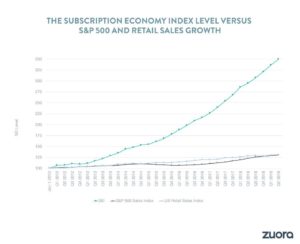
Over the past seven and a half years, the Subscription Economy has continued to thrive, growing more than 350 percent, as consumers increasingly demand access to convenient, digital services over the ownership of physical products.
The latest edition of the biannual Subscription Economy Index from Zuora – the leading cloud-based subscription management provider – has found modest subscriber growth across the media industry with high churn rates.
High churn rates are not surprising in an aggressively contested sector that has seen several major new direct to-consumer entrants.
The publishing industry generated the least amount of revenue from usage-based pricing compared to other industries at 17%. While the sector continues to expand, publishers frequently don’t have as much opportunity to deploy usage-based models than other sectors (newspaper paywalls, for example, are generally priced at a fixed monthly rate).
For the first time since its inception in January 2012, the SEI analysed the impact of subscription businesses by sector, comparing subscription businesses in Software as a Service (SaaS), Internet of Things (IoT), Manufacturing, Publishing, Media, Telecommunications and Business Services to their respective S&P 500 Industry benchmarks.
IDC predicts that by 2020, 50 percent of the world’s largest enterprises will see the majority of their business depends on their ability to create digitally enhanced products, services, and experiences.
The latest SEI report showcases a number of industries contributing to this incredible growth. On average, Zuora found that the sectors outlined in the SEI report are growing 2 to 5 times faster than their industry benchmarks.
“The Subscription Economy is not limited to one or two industries. We’re now seeing sectors far and wide placing subscriptions, over pure-play products, at the centre of their businesses to achieve rapid and sustained long-term growth,” said Dr. Carl Gold, Chief Data Scientist at Zuora. “The SEI report showcases the transition to subscriptions beyond the boundaries of traditional SaaS organisations into the Manufacturing and Business Services sectors, exposing the phenomenal value of the subscription business model in today’s digital age.”

Overall, the SEI data reveals that subscription businesses grew revenues about 5 times faster than S&P 500 company revenues (18.2% versus 3.6%) and U.S. retail sales (18.2% versus 3.7%) from January 1, 2012 to June 30, 2019.
Key industry findings from the SEI report which support the Subscription Economy’s long-term magnitude and viability in various industries include:
- Business services and manufacturing industries experienced the lowest churn rates across all sectors, with 16.2% and 20.4% churn rates, respectively. However, Media (37.1%) and Publishing (28.2%) industries saw the highest amount of churn.
- IoT and manufacturing subscription companies exceeded their industry S&P 500 benchmarks by more than 5X. IoT subscription businesses also achieved the highest annual growth rate of Average Revenue Per Account (ARPA) at 14.3%, more than 2x the SEI average of 6.5%.
- The publishing industry generated the least amount of revenue from usage-based pricing compared to other industries at 17%, while the sector with the highest percentage of usage-based revenue was Business Services (57%).
Overarching Subscription Economy insights derived from these industry findings include:
- Offering subscriptions that serve business-critical functions experience lower customer churn. According to Dr. Gold, “Lower churn could be attributed to the ‘sticky’ nature of B2B subscriptions, which serve mission-critical functions and tend to be deeply embedded within a business’ operations. It could also indicate that new entrants shifting to subscriptions are learning from first-movers to the business model.”
- Launching and monetising new services drive greater individual account growth. According to Dr. Gold, “Add-on and up-sell opportunities inherent in digital services and connected hardware support high ARPA growth rates.”
- Incorporating usage-based pricing facilitates lower churn and higher overall subscription growth. According to Dr. Gold, “Companies in industries like publishing that do not adopt usage billing generally have higher churn than companies like those in SaaS or Business Services that do. This suggests that the balance and flexibility of usage-based pricing plays a useful role in customer engagement and retention.”
Source: Net Imperative

You must be logged in to post a comment Login